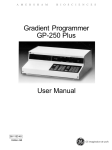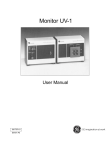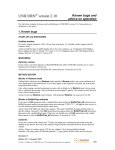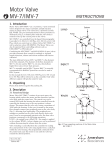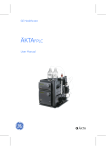Download マニュアル pH Monitor
Transcript
G E H e a l t h c a r e pH Monitor User Manual 59-8310-01 Edition AD Reading this entire manual is recommended for full understanding of the use of this product. The exclamation mark within an equilateral triangle is intended to alert the user to the presence of important operating and maintenance instructions in the literature accompanying the instrument. Should you have any comments on this manual, we will be pleased to receive them at: AGE Healthcare Bio-Sciences AB S-751 82 Uppsala Sweden GE Healthcare Bio-Sciences AB reserves the right to make changes in the specifications without prior notice. Warranty and Liability GE Healthcare Bio-Sciences AB guarantees that the product delivered has been thoroughly tested to ensure that it meets its published specifications. The warranty included in the conditions of delivery is valid only if the product has been installed and used according to the instructions supplied by GE Healthcare Bio-Sciences AB. GE Healthcare Bio-Sciences AB shall in no event be liable for incidental or consequential damages, including without limitation, lost profits, loss of income, loss of business opportunities, loss of use and other related exposures, however caused, arising from the faulty and incorrect use of the product. Trade marks FPLC is the exclusive trade mark of GE Healthcare Bio-Sciences AB. In view of the risk of trade mark degeneration, it is respectfully suggested that authors wishing to use these designations refer to their trade mark status at least once in each article. © Copyright 1995 GE Healthcare Bio-Sciences AB All rights reserved. No part of this publication may be reproduced, stored in a retrieval system or transmitted in any form or by any means, without permission in written form from the company. Reading the entire manual is recommended for full understanding of the use of this product. Contents 1. Introduction . . . . . . . . . . . . . . . . . . . . . . . . . . . . . . . . . . . . . . . . . . . . . . . . . . . . . 5 2. General Description. . . . . . . . . . . . . . . . . . . . . . . . . . . . . . . . . . . . . . . . . . . . . . . . 6 2.1 Front panel. . . . . . . . . . . . . . . . . . . . . . . . . . . . . . . . . . . . . . . . . . . . . . . . . 6 2.2 Rear panel. . . . . . . . . . . . . . . . . . . . . . . . . . . . . . . . . . . . . . . . . . . . . . . . 7 3. Installation . . . . . . . . . . . . . . . . . . . . . . . . . . . . . . . . . . . . . . . . . . . . . . . . . . . . . . . 8 3.1 Unpacking . . . . . . . . . . . . . . . . . . . . . . . . . . . . . . . . . . . . . . . . . . . . . . . . . 8 3.2 Setting up . . . . . . . . . . . . . . . . . . . . . . . . . . . . . . . . . . . . . . . . . . . . . . . . . 8 3.3 Using the pH Monitor as a standard pH meter . . . . . . . . . . . . . . . . .8 3.4 Continuous recording of pH . . . . . . . . . . . . . . . . . . . . . . . . . . . . . . . . . .8 3.5 Calibration of the pH Monitor . . . . . . . . . . . . . . . . . . . . . . . . . . . . . . . . 9 3.6 Range adjustment . . . . . . . . . . . . . . . . . . . . . . . . . . . . . . . . . . . . . . . . . l 0 4. Operation . . . . . . . . . . . . . . . . . . . . . . . . . . . . . . . . . . . . . . . . . . . . . . . . . . . . . . l l 5. Maintenance . . . . . . . . . . . . . . . . . . . . . . . . . . . . . . . . . . . . . . . . . . . . . . . . . . . .l 2 6. Trouble-shooting . . . . . . . . . . . . . . . . . . . . . . . . . . . . . . . . . . . . . . . . . . . . . . . . l 3 7. Technical Specifications . . . . . . . . . . . . . . . . . . . . . . . . . . . . . . . . . . . . . . . . . . l 4 8. Accessories and Spare Parts. . . . . . . . . . . . . . . . . . . . . . . . . . . . . . . . . . . . . . . 1 5 3 4 1. Introduction 1. Introduction The GE Healthcare pH Monitor (Code No. 19-8300-02, 100–120 V and 19-8301-02, 220–240 V) is a high precision instrument which is used with the GE Healthcare flow-through pH electrode (19-8305-01) for continuous measurement of pH in column effluents. The pH measured can be recorded directly on the chromatogram thus providing a valuable check on the progress of chromatofocusing, ion exchange chromatography, affinity . chromatography and other techniques for which pH is an important factor. Together with the GE Healthcare Standard pH Electrode (Code No. 19-8306-01), the pH Monitor can be used as a high precision pH meter for measuring the pH of eluent buffers and other standard solutions. 5 2. General Description 2. General Description 2.1 Front panel pH Monitor 1 2 3 4 5 6 Fig. 1. 6 No. Item Description 1 Digital display 3 1/2 digit LCD with two decimals. The correct pH value is always indicated on the display even if the pH being measured outside the range defined for the recorder. See Low end and Span below 2 Electrode inlet The electrode inlet is for connection of the pH electrode. The connector must be of the BNC type 3 Low end Potentiometer to set the lowest pH to be registred in a pH interval 4 Span Potentiometer to set the width in pH units 5 Zero Potentiometer for calibration of the pH Monitor 6 Slope Potentiometer for calibration of the pH Monitor 2. General Description 2.2 Rear panel Fig. 2. No. I t e m Description 7 Mains inlet Mains cable inlet 8 Fuse holder Mains fuses: 1 x 63 mA for 100–120 V, 60 Hz 1 x 32 mA for 220–240 V, 50 Hz 9 Signal output The pH Monitor has two output ranges for the connection of the recorder, 0-10 mV and 0-1 V 7 3. Installation 3. Installation The pH Monitor is designed for use in normal laboratory conditions. To minimize drift the instrument should not be placed in draught, in direct sunlight, near the compressor or in the fan stream of cold boxes or cold rooms. 3.1 Unpacking Carefully unpack the pH Monitor. Check the contents against the packing list supplied. Inspect for any damage that may have occurred during transit. Report any damage immediately to the local GE Healthcare representative and to the transport company concerned. 3.2 Setting up 1. Check that the fuse holder are fitted with the correctly rated fuse. 2. Check that the voltage of the pH Monitor is correct. Connect the instrument to a grounded mains outlet. Since the instrument only consumes 1.5 VA, there is no ON/OFF switch and the instrument may be left connected to the mains. In this way there is no need for a warm-up period and the pH Monitor is always ready for use. 3.3 Using the pH Monitor as a standard pH meter 1. Connect the Standard pH electrode (Code No. 19-8306-01) to the electrode connector (Fig. 1). 2. Calibrate the pH Monitor according to the procedure in Section 3.5. 3. The instrument is ready for use. 3.4 Continuous recording of 1. Connect the appropriate output (Fig. 2:9) to a recorder using the signal cable supplied with the pH monitor. Using the left and the middle output contacts gives 0-10 mV; using the left and right gives 0-1 V (Fig. 3). To obtain the best stability use the range 0-1 V if possible. 2. The GE Healthcare recorders REC 101/REC 102 are supplied with pin connectors banana type with clamp connection. Connect the screened recorder cable supplied with the pH Monitor to the connecting clamp by pressing down the spring loaded key on the side of the clamp connection and insert the corresponding connecting pin on the signal cable. Release the key. Make sure that they are properly connected. (Fig. 3) 3. Connect the recorder to the mains and press the chart drive OFF button and the zero check button (zero). 4. Switch on the recorder. 5. Set the recorder pen at the Zero position of the chart paper by adjusting the zero adjustment on the recorder. 8 3. Installation 6. Select the corresponding recorder input range (0-10 mV or 0-1V.) 7. Connect the Flow-through pH electrode to the electrode connector (Fig. 1:2). 8. Release the range 0 button. Note: In most chromatographic uses it is advisable to connect the detector cells in series with the following order: UV and pH. If a UV monitor is used, connect the pH Monitor to the outlet of the UV monitor cell. Fig. 3. The pH Monitor connected to recorder REC 102 3.5 Calibration of the pH Monitor It is always necessary to calibrate a pH monitor with the pH electrode to be used in order to adapt the pH monitor to the characteristics of the electrode. A good laboratory routine is to recalibrate the instrument once a day, when the electrode is replaced and if the ambient temperature is changed. If the Flow-through pH electrode is used, the calibration procedure can be done with the pH electrode either fitted or disconnected from the flow cell. Make sure to pump at least 1 ml of the new buffer through the flow cell before adjusting the pH Monitor. When calibrating the electrode disconnected from the flow cell, rinse the electrode with distilled water and dry it with a soft tissue when changing from one buffer to another. 1. Remove air bubbles from the glass membrane and the lower parts of the connecting wires, if necessary, by shaking the electrode like a clinical thermometer. 2. Place the electrode in a standard buffer solution with a pH close to 7. 9 3. Installation 3. Allow the pH Monitor to stabilize and adjust it to the pH of the buffer using the Zero switch. 4. Place the pH Electrode in standard buffer of a different pH. If the instrument will be used predominantly in the pH range above 7, then use a standard buffer with a pH above 7 as the second calibration buffer. Use second calibration buffer with a pH of less than 7, if the measuring range will be below pH 7. 5. Allow the instrument to stabilize and adjust the reading by the potentiometer Slope to the pH of the second calibration buffer chosen under paragraph 4 above. 6. The instrument is now calibrated. Note: If the pH Monitor is to be used at an extreme interval, e.g. between pH 11-13, the calibration procedure has to be slightly modified. Use in this case two calibration buffers, one of pH 11.00 and one of pH 13.00. Put the electrode in the pH 11.00 buffer and adjust the pH Monitor to show this value with the Zero switch. Rinse the electrode with distilled water and then put it in pH 13.00 buffer. Use the Slope knob of the pH Monitor so that the display shows this value. Rinse the electrode with distilled water and go back to the pH 11.00 buffer. If the pH Monitor does not show pH 11.00, adjust to this value with the Zero switch. Rinse the electrode with distilled water and go back to pH 13.00. Set the pH Monitor read-out to show the same value. If the pH Monitor is to be calibrated for instance between pH 2-3, adjust and set pH 3.00 with the Zero switch and pH 2.00 with the Slope knob. In this case also, these operations should be performed twice. Before calibration extremes of pH the monitor must have been calibrated in the standard way as previously described, e.g. betweeen pH 4 and 7 or pH 7 and 10. 3.6 Range adjustment The pH interval registered on the recorder is defined with the two switches Low end and Span on the pH Monitor. 1. Choose the lowest pH to be registred on the recorder by setting Low end at this value. 2. Choose the width in pH units of the interval to be registred on the recorder by setting Span on this value. Example 1: Low End on 3, Span on 5. The pH 3-8 interval will be recorded. Example 2: Low end on 4, Span on 2. The pH 4-6 interval will be recorded. If the pH of the solution is outside the set interval, the display will still show the correct value even if the recorder is off-scale. 10 4. Operation 4. Operation 1. If the instrument is used for Chromatofocusing see Section “Using the Flow-through pH Electrode in Chromatofocusing” in the specifications instructions for the Flow-through pH Electrode. 2. Select the desired chart speed. 3. Start recording by releasing the chart drive button. 11 5. Maintenance 5. Maintenance Wipe the instrument regularly with a damp cloth. Let the instrument dry completely before use. The instrument does not require any regular service. In case of failure, contact your local GE Healthcare representative. 12 6. Trouble-shooting 6. Trouble-shooting If the pH system is not working properly the following test procedure can be performed in order to find out whether the pH Monitor is the cause to the problem. 1. Set the Low end potentiometer to “Test”. 2. Set the Span potentiometer to 3. 3. Turn the Zero and Slope potentiometers fully counter-clockwise. 4. If the pH Monitor is working properly the display should now read pH 10.00 ± pH 0.20 and the Recorder output should give 10.00 mV ± 0.20 mV (on the 10 mV range) or 1.00 V ± 0.02 V (on the 1 V range). This means that the malfunction is to be found in the electrode. After this check it is necessary to recalibrate the instrument as previously described. 13 7. Technical Specification 7. Technical Specifications EMC standards Measuring range pH 0.00-14.00 Precision ± 0.01 pH units Display 3 1/2 digit LCD Drift <0.005 pH units/°C Environment +14 to +32 °C, 20–95% relative humidity, 84-106 kPa (840–1060 mbar) atmospheric pressure Input impedance >1012 Ohm Recorder output 0-10 mV or 0-1 V pH electrode connector BNC type Mains voltage 100–120/220–240 V Frequency 50–60 Hz Fuse T 63 mAL 100–120 V T 32 mAL 220–240 V Power consumption 1.5 VA Dimensions (W x D x H) 215 x 105 x 65 mm Weight 1.5 kg ~ This product meets the requirement of the EMC Directive 89/336/EEC through the harmonized standards EN 50081-2 (emission) and EN 50082-1 (immunity) Note: This is a class A product. In a domestic environment this product may cause radio interference in which case the user may be required to take adequate actions. Note: The declaration of conformity is valid for the instrument when it is: • used in laboratory locations • used in the same state as it was delivered from GE Healthcare Bio-Sciences AB except for alteration described in the User Manual • used as “stand alone” unit or connected to other CE labelled GE Healthcare products or other products as recommended. Safety standards 14 This product meets the requirement of the Low Voltage Directive (LVD) 73/23/EEC through the harmonized standard EN 61010-1. 8. Accessories and Spare Parts 8. Accessories and Spare Parts Please order accessories and spare parts according to the designation and code numbers below. Designation Code No. No. per pack Flow-through pH Electrode (complete with flow cell) 19-8305-01 1 Standard pH Electrode 19-8306-01 1 Signal cable 19-6006-01 1 Fuse 62 mA SB 100/120 V 19-6235-01 2 Fuse 32 mA SB 220/240 V 18-2804-01 5 15
















